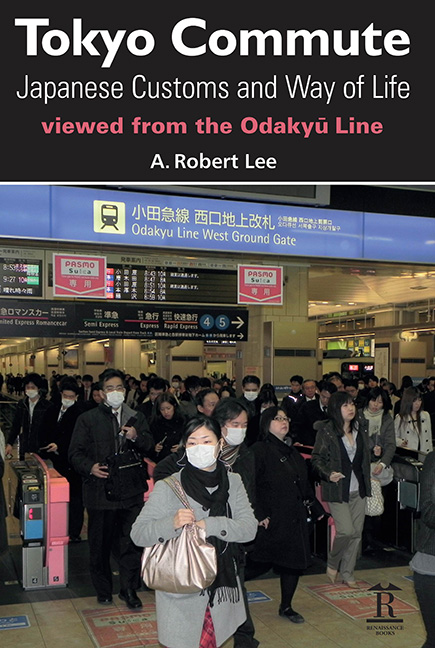Book contents
- Frontmatter
- Dedication
- Acknowledgements
- Contents
- 1 Odakyū-sen
- 2 Shinjuku Station
- 3 Shinjuku
- 4 Mukōgaoka-yūen North
- 5 Mukōgaoka-yūen South
- 6 Mukōgaoka-yūen Platform
- 7 January Monday
- 8 Odakyū Notables
- 9 Odakyū Line Sounds Familiar
- 10 Train Notices
- 11 Odakyū Commercials
- 12 February Tuesday
- 13 Odakyū Keitaispracht
- 14 By-line, Setagaya Line
- 15 March Wednesday
- 16 Odakyū Day-out Sendagi
- 17 Shimo-Kitazawa
- 18 Bicycle!
- 19 Odakyū Bike Interview – Toda-san
- 20 International Interlude via Narita Airport
- 21 Keitai Train Culture
- 22 April Thursday
- 23 Odakyū Tamagawa
- 24 Station Sights
- 25 Odakyū-sen, Yoyogi-Hachiman Eki
- 26 May Friday
- 27 Mukoōgaoka-yūen, Day for Night
- 28 Odakyū Day-out, Hakone
- 29 June Saturday
- 30 Odakyū Commercials
- 31 Odakyū Smokes
- 32 By-line, Nambu Line
- 33 Odakyū Bag Watch
- 34 Seijo Times
- 35 Odakyū Day-out, Yokohama
- 36 July Sunday
- 37 Odakyū Trains of Thought
- 38 Train Signs, Train Sounds
- 39 By-line, Tama Express
- 40 August Monday
- 41 Odakyū Day-out, Chiba
- 42 September Tuesday
- 43 Odakyū Lady-grooming
- 44 Odakyū and Near-Odakyū Women’s Hairday
- 45 Odakyū Evenings-out
- 46 October Wednesday
- 47 Odakyū Day-out, Ibaraki
- 48 Chikan! Odakyū Misbehaviour
- 49 November Thursday
- 50 Odakyū Blues
- 51 Odakyū Men’s Haircut
- 52 Odakyū Day-out, Ō-Sumo
- 53 December Friday
- 54 Odakyū Store
- 55 Odakyū Bookshelf
- 56 Last Train
- Glossary
41 - Odakyū Day-out, Chiba
Published online by Cambridge University Press: 26 May 2022
- Frontmatter
- Dedication
- Acknowledgements
- Contents
- 1 Odakyū-sen
- 2 Shinjuku Station
- 3 Shinjuku
- 4 Mukōgaoka-yūen North
- 5 Mukōgaoka-yūen South
- 6 Mukōgaoka-yūen Platform
- 7 January Monday
- 8 Odakyū Notables
- 9 Odakyū Line Sounds Familiar
- 10 Train Notices
- 11 Odakyū Commercials
- 12 February Tuesday
- 13 Odakyū Keitaispracht
- 14 By-line, Setagaya Line
- 15 March Wednesday
- 16 Odakyū Day-out Sendagi
- 17 Shimo-Kitazawa
- 18 Bicycle!
- 19 Odakyū Bike Interview – Toda-san
- 20 International Interlude via Narita Airport
- 21 Keitai Train Culture
- 22 April Thursday
- 23 Odakyū Tamagawa
- 24 Station Sights
- 25 Odakyū-sen, Yoyogi-Hachiman Eki
- 26 May Friday
- 27 Mukoōgaoka-yūen, Day for Night
- 28 Odakyū Day-out, Hakone
- 29 June Saturday
- 30 Odakyū Commercials
- 31 Odakyū Smokes
- 32 By-line, Nambu Line
- 33 Odakyū Bag Watch
- 34 Seijo Times
- 35 Odakyū Day-out, Yokohama
- 36 July Sunday
- 37 Odakyū Trains of Thought
- 38 Train Signs, Train Sounds
- 39 By-line, Tama Express
- 40 August Monday
- 41 Odakyū Day-out, Chiba
- 42 September Tuesday
- 43 Odakyū Lady-grooming
- 44 Odakyū and Near-Odakyū Women’s Hairday
- 45 Odakyū Evenings-out
- 46 October Wednesday
- 47 Odakyū Day-out, Ibaraki
- 48 Chikan! Odakyū Misbehaviour
- 49 November Thursday
- 50 Odakyū Blues
- 51 Odakyū Men’s Haircut
- 52 Odakyū Day-out, Ō-Sumo
- 53 December Friday
- 54 Odakyū Store
- 55 Odakyū Bookshelf
- 56 Last Train
- Glossary
Summary
Resident Chiba-ites may not thank you for saying so but the region has acquired its modern reputation for two principal reasons: it acts as dormitory Tokyo and it is host to Narita Airport. For sure this does an injustice. Chiba Prefecture (Chiba-ken) has any number of other claims. Six million people make their home there, by no means all commuters. If there is industry (chemicals, coal, steel) there is also farmland (rice, daikon and other vegetables, flowers), if fisheries (a considerable shoreline extending into the Pacific and Tokyo Bay) then also the Kanto Plain. Chiba was also an ancient hemp-growing region. A ‘day-out’ can also get you to rivers like the winningly named Mama River or Chiba port, also much beach. Beckoning climate – not least the summer cool.
Two trips in one. Two species of temple visit. First to Narita (properly Narita-shi), not the airport but the village, an area known as Sanrizuka. Then to the Tokyo Disney Resort.
Sacred and Secular. Fudōmyōō (deity) and Mickey Mouse (celebrity). The Japan of Indian-imported spiritual tradition, the Japan of American-imported funfair modernity.
Both yours, starting from the Odakyū, at 80 or so kilometres east of Tokyo.
NARITA-SAN SHINJOJI TEMPLE
Off one heads, Odakyū-sen to Yoyogi-Uehara, change to the Chiyoda Line, and on out to Abiko. Another change at Abiko to the Narita Line and then to Narita itself. The few minutes walk from the station takes you past a street of wood-structured shops, more than a hundred of them in all, full of hives and troves of small-sale food, knick-knacks, mementos. Time, however, jumps. This is but the threshold to Shingon-sect Buddhism begun in 940. The overwhelming centrepiece is the Narita-san Temple, fulcrum and radial gathering-point of the considerable temple complex.
A prayer-to-ancestors stairway. A bell to summon ancestors. Holy incense-smoke. Altars of gold imagery. Lotus motifs. Purpleclad priests. The whole at once stately, a necessary stillness amid the visitors. Two five-storey pagodas give architectural accompaniment, especially the Pagoda of Peace. More is all to hand – the Gaku-dō Hall, the Niō-mon Gate. It may well be crowded during the day, but there is no doubting the invitation to self-space, innerness.
- Type
- Chapter
- Information
- Tokyo CommuteJapanese Customs and Way of Life Viewed from the Odakyū Line, pp. 160 - 162Publisher: Amsterdam University PressPrint publication year: 2011



